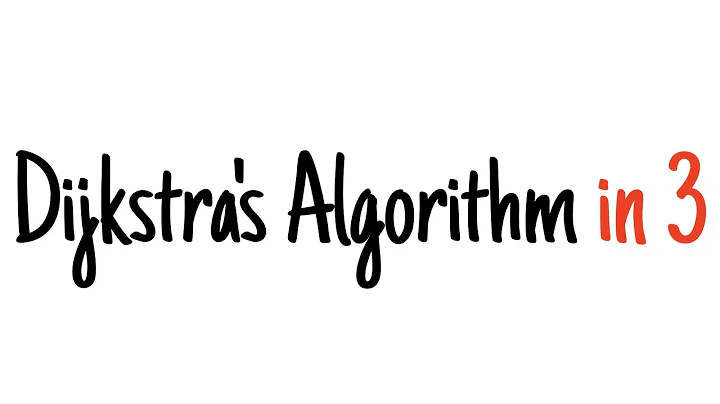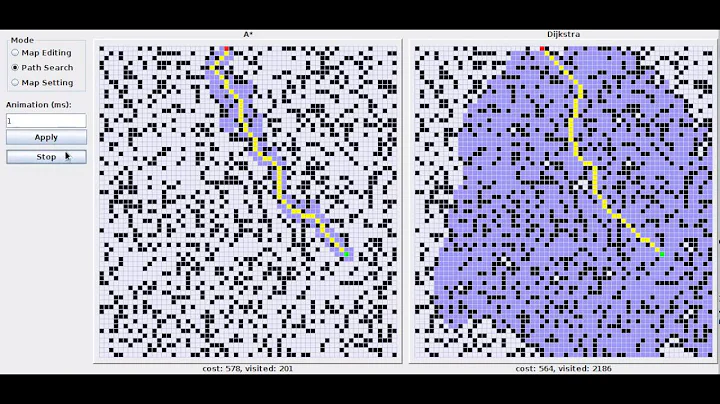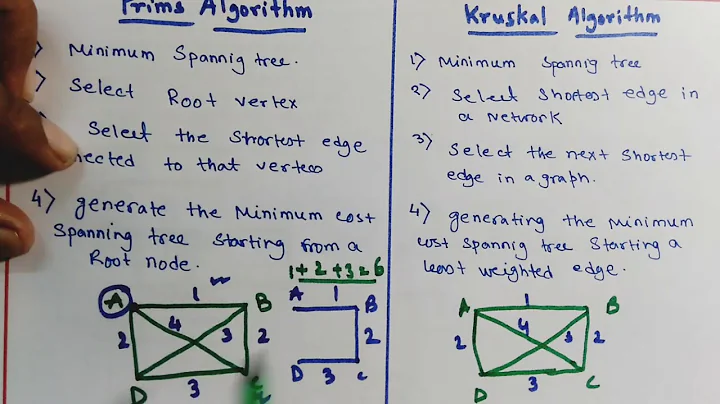Difference between Prim's and Dijkstra's algorithms?
Solution 1
Prim's algorithm constructs a minimum spanning tree for the graph, which is a tree that connects all nodes in the graph and has the least total cost among all trees that connect all the nodes. However, the length of a path between any two nodes in the MST might not be the shortest path between those two nodes in the original graph. MSTs are useful, for example, if you wanted to physically wire up the nodes in the graph to provide electricity to them at the least total cost. It doesn't matter that the path length between two nodes might not be optimal, since all you care about is the fact that they're connected.
Dijkstra's algorithm constructs a shortest path tree starting from some source node. A shortest path tree is a tree that connects all nodes in the graph back to the source node and has the property that the length of any path from the source node to any other node in the graph is minimized. This is useful, for example, if you wanted to build a road network that made it as efficient as possible for everyone to get to some major important landmark. However, the shortest path tree is not guaranteed to be a minimum spanning tree, and the sum of the costs on the edges of a shortest-path tree can be much larger than the cost of an MST.
Another important difference concerns what types of graphs the algorithms work on. Prim's algorithm works on undirected graphs only, since the concept of an MST assumes that graphs are inherently undirected. (There is something called a "minimum spanning arborescence" for directed graphs, but algorithms to find them are much more complicated). Dijkstra's algorithm will work fine on directed graphs, since shortest path trees can indeed be directed. Additionally, Dijkstra's algorithm does not necessarily yield the correct solution in graphs containing negative edge weights, while Prim's algorithm can handle this.
Hope this helps!
Solution 2
Dijkstra's algorithm doesn't create a MST, it finds the shortest path.
Consider this graph
5 5
s *-----*-----* t
\ /
-------
9
The shortest path is 9, while the MST is a different 'path' at 10.
Solution 3
Prim and Dijkstra algorithms are almost the same, except for the "relax function".
Prim:
MST-PRIM (G, w, r) {
for each key ∈ G.V
u.key = ∞
u.parent = NIL
r.key = 0
Q = G.V
while (Q ≠ ø)
u = Extract-Min(Q)
for each v ∈ G.Adj[u]
if (v ∈ Q)
alt = w(u,v) <== relax function, Pay attention here
if alt < v.key
v.parent = u
v.key = alt
}
Dijkstra:
Dijkstra (G, w, r) {
for each key ∈ G.V
u.key = ∞
u.parent = NIL
r.key = 0
Q = G.V
while (Q ≠ ø)
u = Extract-Min(Q)
for each v ∈ G.Adj[u]
if (v ∈ Q)
alt = w(u,v) + u.key <== relax function, Pay attention here
if alt < v.key
v.parent = u
v.key = alt
}
The only difference is pointed out by the arrow, which is the relax function.
- The Prim, which searches for the minimum spanning tree, only cares about the minimum of the total edges cover all the vertices. The relax function is
alt = w(u,v) - The Dijkstra, which searches for the minimum path length, so it cares about the edge accumulation. The relax function is
alt = w(u,v) + u.key
Solution 4
Dijsktra's algorithm finds the minimum distance from node i to all nodes (you specify i). So in return you get the minimum distance tree from node i.
Prims algorithm gets you the minimum spaning tree for a given graph. A tree that connects all nodes while the sum of all costs is the minimum possible.
So with Dijkstra you can go from the selected node to any other with the minimum cost, you don't get this with Prim's
Solution 5
The only difference I see is that Prim's algorithm stores a minimum cost edge whereas Dijkstra's algorithm stores the total cost from a source vertex to the current vertex.
Dijkstra gives you a way from the source node to the destination node such that the cost is minimum. However Prim's algorithm gives you a minimum spanning tree such that all nodes are connected and the total cost is minimum.
In simple words:
So, if you want to deploy a train to connecte several cities, you would use Prim's algo. But if you want to go from one city to other saving as much time as possible, you'd use Dijkstra's algo.
Related videos on Youtube
Comments
-
anuj pradhan about 2 years
What is the exact difference between Dijkstra's and Prim's algorithms? I know Prim's will give a MST but the tree generated by Dijkstra will also be a MST. Then what is the exact difference?
-
 JW.ZG about 7 yearsThe best way to distinguish their difference is read some source code, Dijkstra and Prim. The main difference is here: for Prim
JW.ZG about 7 yearsThe best way to distinguish their difference is read some source code, Dijkstra and Prim. The main difference is here: for Primgraph[u][v] < key[v], and for Dijkstradist[u]+graph[u][v] < dist[v]. So as you can see from the graphs in those two pages, they are different mainly because of these two lines of code. -
 e4c5 about 7 yearsPossible duplicate of What is the difference between Dijkstra and Prim's algorithm?
e4c5 about 7 yearsPossible duplicate of What is the difference between Dijkstra and Prim's algorithm? -
greybeard about 2 yearsMeta difference: I think there's just one algorithm designated Prim's, but multiple Dijkstra's, one being notorious for variations.
-
-
anuj pradhan over 11 yearsOk thanks ...you cleared a good point to notice. Till now i was considering that the output generated by dijkstra will be a MST but you cleared the doubt with a good example .I can see clearly if i will find a MST using say 'kruskal' then i will get the same path as you mentioned. Thanks a lot
-
 Bernhard Barker over 11 yearsMore correctly -
Bernhard Barker over 11 yearsMore correctly -The shortest path is 9... from s to t. The weight of the graph generated by Dijkstra's algorithm, starting at s, is 14 (5+9). -
dfb over 11 years@Dukeling - Huh? the weight of the tree/graph in Dijkstra's is meaningless, that's sort of the point....
-
 Bernhard Barker over 11 years@dfb You were proving it's not an MST, so the weight is important for that. As in 14 > 10, so it's not an MST.
Bernhard Barker over 11 years@dfb You were proving it's not an MST, so the weight is important for that. As in 14 > 10, so it's not an MST. -
Ram Narasimhan almost 10 yearsVery succinctly illustrated!
-
tmyklebu over 9 years"Dijkstra is concerned with only two nodes" is bunk.
-
 Ankit Roy over 9 years@dfb: Normally we only run Dijkstra's algorithm to get the shortest path between a specific pair of vertices, but in fact you can keep going until all vertices have been visited, and this will give you a "shortest path tree", as templatetypedef's answer explains.
Ankit Roy over 9 years@dfb: Normally we only run Dijkstra's algorithm to get the shortest path between a specific pair of vertices, but in fact you can keep going until all vertices have been visited, and this will give you a "shortest path tree", as templatetypedef's answer explains. -
amirouche over 8 yearsThanks! The exit is nebulous, why does it exit the loop even if nothing happens?
-
nethsix about 8 yearsAt the code level, the other difference is the API. Prim has method
edges()to return MST edges, while Dijkstra hasdistanceTo(v),pathTo(v), which respectively returns distance from source to vertex v, and path from source to vertex v, where s is the vertex your initialize Dijkstra with. -
nethsix about 8 yearsCorollary, initializing Prim with any any source vertex, s returns the same output for
edges(), but initialization Dijkstra with different s will return different output fordistanceTo(v),pathTo(v). -
 Akhil Dad over 7 yearsDoes prims allow negative weight? if yes than this is another difference. I read that you can allow negative weights on prim's by adding large positive no. to each value, making it all positive.
Akhil Dad over 7 yearsDoes prims allow negative weight? if yes than this is another difference. I read that you can allow negative weights on prim's by adding large positive no. to each value, making it all positive. -
 JW.ZG about 7 yearsThe first paragraph makes no sense, man. The question is what's the difference between Dijkstra and Prim, where Dijkstra is not about what you said
JW.ZG about 7 yearsThe first paragraph makes no sense, man. The question is what's the difference between Dijkstra and Prim, where Dijkstra is not about what you saidthe length of a path between **any** two nodes, you should just focus why the distance between src node and any other nodes in Prim is not shortest if it is not shortest. I think he must be asking the src node in Prim to any other node. Why did you talk about any two nodes in Prim? That's of course not the shortest. -
templatetypedef about 7 yearsI've cleaned up the wording in the paragraph about Dijkstra's algorithm to clarify that the shortest path tree is only a minimizer for shortest paths originating at the source node. The reason I've structured my answer this was way to illustrate what the algorithms find rather than how they work to show at a higher level why they produce different outcomes and why you wouldn't expect them to be the same.
-
information_interchange over 5 yearsTo see why Dijkstra's and Prim's might not return the same thing, consider a radial graph with a center node connected to say 4 other nodes, each with weight 3. Then, imagine that between two of those non-central nodes, there is an edge with weight 4. The shortest path between those two nodes is via the direct connection, but this edge will not be included in the MST.
-
Dhananjay Sarsonia over 4 yearsSolved my confusion! Perfect Answer!!
-
 Deepak Yadav over 4 yearsThe simplest explanation is in Prims you don't specify the Starting Node, but in dijsktra you (Need to have a starting node) have to find shortest path from the given node to all other nodes. See stackoverflow.com/a/51605961/6668734
Deepak Yadav over 4 yearsThe simplest explanation is in Prims you don't specify the Starting Node, but in dijsktra you (Need to have a starting node) have to find shortest path from the given node to all other nodes. See stackoverflow.com/a/51605961/6668734 -
 Mr X over 4 yearshere the processed vertex has to ignored for undirected graph
Mr X over 4 yearshere the processed vertex has to ignored for undirected graph -
Peter about 4 yearsI don't understand this graph thou, can someone tell me what is this ?
-
 Amelio Vazquez-Reina about 4 years@DeepakYadav Some definitions of Prim's (e.g. CLRS') assume that you actually provide a starting vertex. You may instead say that Prim's returns an MST (and thus solves the stated problem) regardless of what vertex you start with, whereas in Dijkstra's, providing different vertices solves different (single-source) shortest path problems.
Amelio Vazquez-Reina about 4 years@DeepakYadav Some definitions of Prim's (e.g. CLRS') assume that you actually provide a starting vertex. You may instead say that Prim's returns an MST (and thus solves the stated problem) regardless of what vertex you start with, whereas in Dijkstra's, providing different vertices solves different (single-source) shortest path problems. -
 Amelio Vazquez-Reina about 4 years@templatetypedef - When you say: "and the cost of building such a tree [with Dijkstra] could be much larger than the cost of an MST." can you please elaborate?
Amelio Vazquez-Reina about 4 years@templatetypedef - When you say: "and the cost of building such a tree [with Dijkstra] could be much larger than the cost of an MST." can you please elaborate? -
templatetypedef about 4 years@AmelioVazquez-Reina Sorry, that bit is ambiguous. What I meant is that the sum of the weights on the edges of a shortest-paths tree can be much larger than the sum of the weights on the edges in an MST.
-
 Amelio Vazquez-Reina about 4 years+1 Thanks. That's actually what I assumed you meant :). I think if you replace that sentence with exactly what you wrote, this answer will be even clearer/better.
Amelio Vazquez-Reina about 4 years+1 Thanks. That's actually what I assumed you meant :). I think if you replace that sentence with exactly what you wrote, this answer will be even clearer/better. -
templatetypedef about 4 yearsYep, just did that.
-
fkotsian almost 3 yearsIncredible answer! Had an intuition that the two algos were extremely similar but couldn't put my finger on exactly how - thanks for this beautiful answer!
-
 LomoY over 2 years@templatetypedef Thanks for the explanation, one more thing I want to add to this answer. Prim could handle negative edges, while Dijkstra can only work on graphs with positive edges.
LomoY over 2 years@templatetypedef Thanks for the explanation, one more thing I want to add to this answer. Prim could handle negative edges, while Dijkstra can only work on graphs with positive edges. -
Zack Light almost 2 yearsI think @AkhilDad is right about the second difference. Also, I think the pseudocode needs a bit of logic to check if a node has been visited before or not






